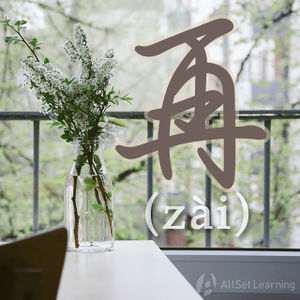Difference between revisions of "Expressing "in addition" with "zaishuo""
m (Text replace - "{{Grammar Box}} " to "{{Grammar Box}} ") |
m (Text replace - "(\r?\n){2}" to "\r\n") |
||
| Line 1: | Line 1: | ||
| − | {{Grammar Box}} | + | {{Grammar Box}} \r\n"再说..." (zàishuō...) is used in a similar way as "In addition" or "Moreover", in that it is adding on additional information or reasons to the topic at hand.\r\n== Structure ==\r\nJust add 再说 to the beginning of the second clause of your sentence. Remember that both statements should be related to each other!\r\n<div class="jiegou">\r\nClause 1 , 再说 + Clause 2\r\n</div>\r\n== Examples == |
| − | + | <div class="liju">\r\n*我还不想结婚,因为年纪太小了。<em>再说</em> ,也没有遇到合适的人。<span class="trans">I haven't got a plan on getting married yet.I‘m still young and besides,I haven't met the right one.</span> | |
| − | "再说..." (zàishuō...) is used in a similar way as "In addition" or "Moreover", in that it is adding on additional information or reasons to the topic at hand. | ||
| − | |||
| − | == Structure == | ||
| − | |||
| − | |||
| − | |||
| − | <div class="jiegou"> | ||
| − | |||
| − | |||
| − | |||
| − | </div> | ||
| − | |||
| − | == Examples == | ||
| − | <div class="liju"> | ||
| − | |||
| − | *我还不想结婚,因为年纪太小了。<em>再说</em> ,也没有遇到合适的人。<span class="trans">I haven't got a plan on getting married yet.I‘m still young and besides,I haven't met the right one.</span> | ||
*现在 太 早 了,我 不 想 去,<em>再说</em> 那 个 商店 还 没 开门。<span class="trans">It's too early now.I don't want to go. The store hasn't opened yet, anyway.</span> | *现在 太 早 了,我 不 想 去,<em>再说</em> 那 个 商店 还 没 开门。<span class="trans">It's too early now.I don't want to go. The store hasn't opened yet, anyway.</span> | ||
| − | *我 不想 帮助 他,因为 他 经常 说谎,<em>再说</em> 我 也 没 钱。<span class="trans">I don't want to help him. He lies a lot. Furthermore, I don't have any money. </span> | + | *我 不想 帮助 他,因为 他 经常 说谎,<em>再说</em> 我 也 没 钱。<span class="trans">I don't want to help him. He lies a lot. Furthermore, I don't have any money. </span>\r\n</div>\r\n==See also== |
| − | |||
| − | </div> | ||
| − | |||
| − | ==See also== | ||
*[["In addition" as "lingwai"]] | *[["In addition" as "lingwai"]] | ||
*[[Expressing "in addition" with "haiyou"]] | *[[Expressing "in addition" with "haiyou"]] | ||
| − | *[[Expressing "not only… but also"]] | + | *[[Expressing "not only… but also"]]\r\n== Sources and further reading ==\r\n=== Books ===\r\n* [[Common Chinese Patterns 330 (汉语常用格式330例) ]] (pp. 297)[http://www.amazon.com/gp/product/7802006473/ref=as_li_ss_tl?ie=UTF8&tag=allset-20&linkCode=as2&camp=217145&creative=399373&creativeASIN=7802006473 →buy] |
| − | |||
| − | == Sources and further reading == | ||
| − | |||
| − | === Books === | ||
| − | |||
| − | * [[Common Chinese Patterns 330 (汉语常用格式330例) ]] (pp. 297)[http://www.amazon.com/gp/product/7802006473/ref=as_li_ss_tl?ie=UTF8&tag=allset-20&linkCode=as2&camp=217145&creative=399373&creativeASIN=7802006473 →buy] | ||
* [[Integrated Chinese: Level 1, Part 2 (3rd ed)]] (pp. 154-5) [http://www.amazon.com/gp/product/0887276709/ref%3das_li_ss_tl?ie=UTF8&tag=allset-20&linkCode=as2&camp=217145&creative=399369&creativeASIN=0887276709 →buy] | * [[Integrated Chinese: Level 1, Part 2 (3rd ed)]] (pp. 154-5) [http://www.amazon.com/gp/product/0887276709/ref%3das_li_ss_tl?ie=UTF8&tag=allset-20&linkCode=as2&camp=217145&creative=399369&creativeASIN=0887276709 →buy] | ||
* [[Integrated Chinese: Level 2, Part 1]] (pp. 17-8) [http://www.amazon.com/gp/product/0887276792/ref%3das_li_ss_tl?ie=UTF8&tag=allset-20&linkCode=as2&camp=217145&creative=399369&creativeASIN=0887276792 →buy] | * [[Integrated Chinese: Level 2, Part 1]] (pp. 17-8) [http://www.amazon.com/gp/product/0887276792/ref%3das_li_ss_tl?ie=UTF8&tag=allset-20&linkCode=as2&camp=217145&creative=399369&creativeASIN=0887276792 →buy] | ||
| − | * [[Modern Mandarin Chinese Grammar: A Practical Guide]] (pp. 252) [http://www.amazon.com/gp/product/0415700108?ie=UTF8&tag=allset-20&linkCode=as2&camp=1789&creative=390957&creativeASIN=0415700108 →buy] | + | * [[Modern Mandarin Chinese Grammar: A Practical Guide]] (pp. 252) [http://www.amazon.com/gp/product/0415700108?ie=UTF8&tag=allset-20&linkCode=as2&camp=1789&creative=390957&creativeASIN=0415700108 →buy] \r\n[[Category:B1 grammar points]] |
| − | + | [[Category:Connectors]]\r\n{{Basic Grammar|再说|B1|再说……|<em>再说</em>,时间 不 早 了。|grammar point|ASGATDLX}} | |
| − | [[Category:B1 grammar points]] | ||
| − | [[Category:Connectors]] | ||
| − | |||
| − | {{Basic Grammar|再说|B1|再说……|<em>再说</em>,时间 不 早 了。|grammar point|ASGATDLX}} | ||
{{Rel char|再}} | {{Rel char|再}} | ||
{{Rel char|说}} | {{Rel char|说}} | ||
Revision as of 06:09, 26 November 2013
-
Level
-
Similar to
-
Used for
-
Keywords
\r\n"再说..." (zàishuō...) is used in a similar way as "In addition" or "Moreover", in that it is adding on additional information or reasons to the topic at hand.\r\n== Structure ==\r\nJust add 再说 to the beginning of the second clause of your sentence. Remember that both statements should be related to each other!\r\n
\r\nClause 1 , 再说 + Clause 2\r\n
\r\n== Examples ==
\r\n*我还不想结婚,因为年纪太小了。再说 ,也没有遇到合适的人。I haven't got a plan on getting married yet.I‘m still young and besides,I haven't met the right one.
- 现在 太 早 了,我 不 想 去,再说 那 个 商店 还 没 开门。It's too early now.I don't want to go. The store hasn't opened yet, anyway.
- 我 不想 帮助 他,因为 他 经常 说谎,再说 我 也 没 钱。I don't want to help him. He lies a lot. Furthermore, I don't have any money. \r\n
\r\n==See also==



